Institute of Oceanology, Chinese Academy of Sciences
Article Information
- LIU Qi, CUI Nini, FENG Jia, LÜ Junping, NAN Fangru, LIU Xudong, XIE Shulian, KOCIOLEK John Patrick
- Gomphonema Ehrenberg species from the Yuntai Mountains, Henan Province, China
- Journal of Oceanology and Limnology, 39(3): 1042-1062
- http://dx.doi.org/10.1007/s00343-020-0103-9
Article History
- Received Feb. 26, 2020
- accepted in principle Apr. 17, 2020
- accepted for publication May. 22, 2020
2 Museum of Natural History and Department of Ecology and Evolutionary Biology, University of Colorado, UCB 218, Boulder CO 80309, USA
Work on the taxonomy of freshwater gomphonemoid diatoms of Asia has a long history and has been enjoying a revival in the last decade or so. Descriptions of new taxa occurred during the middle and the end of the 19th century, with species described from the region by Ehrenberg (1854), Grunow (in van Heurck, 1880) and Brun (in Schmidt, 1899). New species were described from Asia into the 20th century, including the work by Hustedt(1922, 1927) Meister (1932), Amossé (1969), Gandhi(1958, 1960), Foged (1971), Lange-Bertalot and Genkal (1999), and similar studies have continued into the 21st century by Kulikovskiy and colleagues (Kulivoskiy and Kociolek, 2014; Glushchenko et al., 2017) and Kociolek et al.(2015a, 2018).
In China, specifically, Skvortzow(1929, 1935, 1937, 1938, 1946) documented many new gomphonemoid species from mostly the eastern part of the country. A review of gomphonemoid diatoms from China was presented by Shi (2004), who described 9 new taxa. Bao and Reimer (1992) described a new variety, and Fan et al. (2004) described two new taxa, all from northeastern China. Liu et al. (2013) described six new Gomphonema species from the same region within China. Li and her colleagues (Li et al., 2006, 2010; Gong and Li, 2012), as well as Jiang et al. (2018) documented new gomphonemoid diatoms from Yunnan Province, and You et al. (2015) documented new species from Xinjiang Uygur Autonomous Region, China. Kociolek et al. (2015b) described a new genus Gomphosinica of gomphonemoid diatom from China and an additional species was subsequently described from Yunnan Province (Cheng et al., 2018).
The purpose of the present report is to use light and scanning electron microscopy to report on eight Gomphonema species from the Yuntai Mountains of Henan Province, China, five of which are new to science.
2 MATERIAL AND METHOD 2.1 CollectionDiatom samples were collected during an expedition to the Yuntai Mountains, Xiuwu County, Henan Province, China. Five samples were noted to contain new or interesting species (Fig. 1). These are described below:

|
| Fig.1 Sampling sites of Yuntai Mountains, Henan Province, China; Digital Elevation Model (DEM) A, B, C and D present sample sites 201805021-1, 201805036-1, 201805045-1/201805046-1, and 201805050-1, respectively. |
Samples:
201805021-1: Henan Province, Yuntai Mounweitains, Tanpu valley, river, periphyton, China (35°27′31′′N, 113°20′50″E), there were four Gomphonema species identified in this sample, Gomphonema lanceolatoides sp. nov., Gomphonema montanaviva sp. nov., Gomphonema pseudintricatum sp. nov. and Gomphonema vibrio.
201805036-1: Henan Province, Yuntai Mountains, Tanpu valley, wet wall, periphyton, China (35°30′10″N, 113°25′4″E), this sample contained two Gomphonema species, Gomphonema lateripunctatum and Gomphonema yuntaiensis sp. nov.
201805045-1: Henan Province, Yuntai Mountains, Tanpu valley, wet wall, periphyton, China (35°29′54′′N, 113°25′40″E), there is only one Gomphonema species appear in this sample, Gomphonema pseudosphaerophorum.
201805046-1: Henan Province, Yuntai Mountains, Tanpu valley, wet wall, benthic, China (35°29′54′′N, 113°25′40″E), a single Gomphonema species, Gomphonema fortissimo.
201805050-1: Henan Province, Yuntai Mountains, Tanpu valley, wet wall, periphyton, China (35°29′34′′N, 113°26′9″E), there were two Gomphonema species in this sample, Gomphonema lanceolatoides sp. nov., Gomphonema fortissimo.
Surface water temperature and pH were measured using a HANNA HI 98128 pH meter.
2.2 Sample processingSamples were digested with hydrochloric acid to remove organic matter by cooked. After repeated dilutions of the treated material with distilled water, aliquots were dried on cover glasses and mounted in Naphrax (Brunel Microscopes Ltd., Chippenham, UK). All Light microscopy (LM) observations were performed using an Olympus BX-51 light microscope with a 100× oil immersion objective (numerical aperture 1.40). Specimen images were taken using an Olympus DP72 digital camera at Shanxi University, China.
For Scanning electron microscopy (SEM) observations, the cleaned specimens were air-dried onto glass cover slips, attached to copper stubs, and coated with approximately 15 nm of gold-palladium. Scanning electron microscope observations were made using a Hitachi SU8010 SEM at a working distance less than 6mm and accelerating voltage set at 2 kV at Shanghai Normal University, China.
Holotype slides and material are stored at the Q. LIU Diatom Collection in the Freshwater Algal Herbarium of Shanxi University, China. Isotype slides are deposited in the Kociolek Collection at the University of Colorado (COLO), USA.
3 RESULT Gomphonema cf. lateripunctatum Reichardt & Lange-Bertalot 1991Figures 1–18.
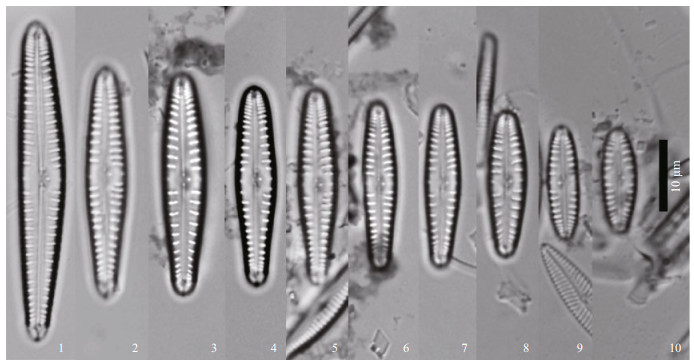
|
| Plate 1 Gomphonema cf. lateripunctatum Reichardt & Lange-Bertalot Figures 1-10: LM, valve views, showing size diminution series. |
Description: valves liner-lanceolate-clavate, with rounded poles. Length 15–45 μm, breadth 4.5– 6.0 μm. Axial area narrow, widening towards the center, expanded laterally to form a wide, asymmetrical, nearly rectangular central area. One short stria is positioned on one side of the central area, the side bearing the stigma. A single, round stigma is located in the central area, near the proximal raphe ends. Raphe straight or weakly undulate, lateral, with distinct, dilated external proximal raphe ends, recurved internal raphe ends. Striae indistinctly punctate, parallel to radiate most of the length of the valve, strongly radiate at the poles. Striae density (8– 9)/10 μm in the center of the valve, condensed at both the headpole and footpole. Septa and pseudosepta are distinct. A bilobed apical pore field (APF) is evident at the footpole.
SEM observations: externally, the areolae are round to ellipsoidal in shape, and without occlusions (Figs. 11–14). At the headpole, striae are more condensed than at the center of the valve (Figs. 11, 12), and the distal raphe end is deflected before extending onto the valve mantle (Fig. 12). Striae extend from the valve face onto the mantle. In the center of the valve, the stigma opening is round and similar in size and shape to the areolae. Proximal raphe ends are dilated (Fig. 13). At the footpole, the raphe bends between the two lobes of the APF. Porelli of the APF are of physically separated from the areolae, but resemble them in overall size and shape (Fig. 14). The APF extends onto the valve face, but is mostly on the mantle.
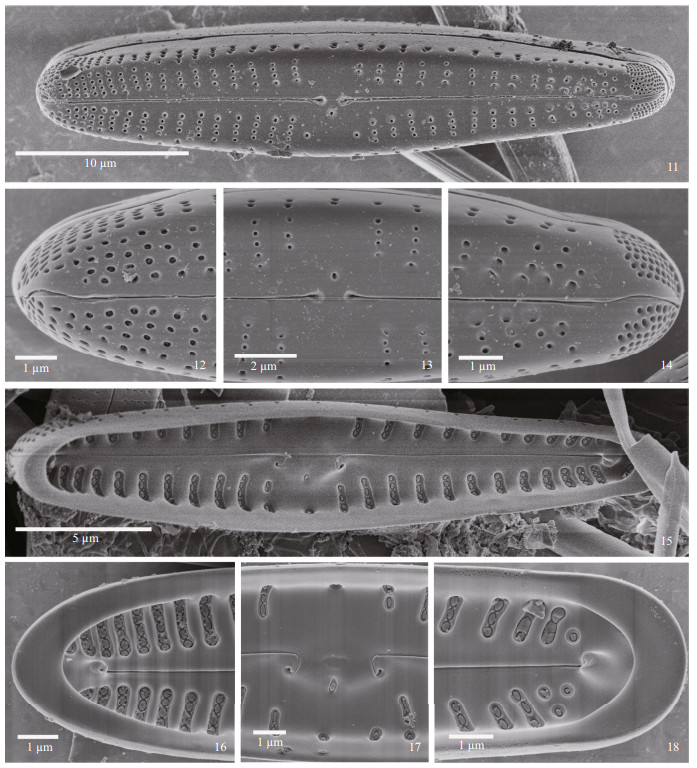
|
| Plate 2 Gomphonema cf. lateripunctatum Reichardt & Lange-Bertalot 1991 Figures 11-18: SEM; Figs. 11-14: external views; Fig. 11: entire valve, showing the straight raphe with dilated proximal ends and rounded areolae without occlusions; Fig. 12: headpole, with round areolae, striae ending onto the mantle and deflected distal raphe end evident; Fig. 13: center of the valve, showing expanded central area, dilated proximal raphe ends and small, round stigma opening; Fig. 14: footpole has an apical pore field that is separated from the striae but the porelli resemble areolae in size and structure; Figs. 15-18: internal views; Fig. 15: whole valve with large central nodule, helictoglossae and pseudosepta evident; Fig. 16: headpole, with prominent helictoglossa and pseudoseptum shown. Areolar occlusions are evident; Fig. 17: central area, showing stigma opening and areolae with occlusions. Proximal raphe ends are recurved at each end of the central nodule; Fig. 18: footpole, with helictoglossa and wide pseudoseptum present. Areolar occlusions are evident. |
Internally, there is a distinct central nodule and pseudosepta at the poles (Figs. 15–18). The raphe appears slightly undulate, with proximal ends recurved on the central nodule. Thee raphe terminates distally as prominent helictoglossae (Figs. 15–18). Areolae occur in troughs between thick interstriae, and are occluded with round hymenes (Figs. 15–18). The stigma is also occluded internally.
Comments: Our specimens match up well with some interpretations of this taxon, such as those presented by Delgado et al. (2013) from Spain and Jüttner (2018) from Scotland. It is reported from alpine areas in Italy (Cantonati et al., 2012), Austria (Trobej et al., 2017) and in Nepal (Jüttner et al., 2018), though the latter population has a more linear outline than the specimens we encountered from the Yuntai Mountains.
Our designation of these specimens as "cf." involves uncertainty around the original description of the taxon by Reichardt and Lange-Bertalot (1991). Specimens included in the original description appear to represent several taxa (compare the shapes and striae densities of their Figs. 8 & 9, which appears to be a separate taxon from what might be considered the commonly reported morphology in their Figs. 3 & 12). The original description reported breadth up to 14 μm, and striae densities up to 14/10 μm, but subsequent reports of breadth are up to 6 μm (here) or lower, and striae densities of (8–12)/10 μm.
Gomphonema yuntaiensis sp. nov.Figures 19–36. Figure 21 is of the holotype.
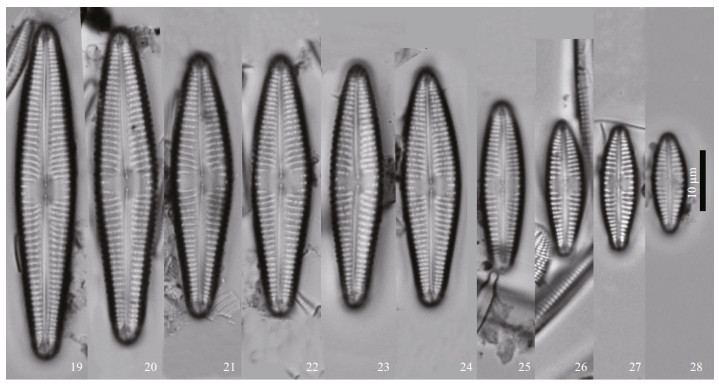
|
| Plate 3 Gomphonema yuntaiensis sp. nov. Figures 19-28: LM, valve views, showing size diminution series. Figure 21 is of the holotype. |
Description: Valves elliptical-lanceolate-clavate, with rounded apices. Length 25–70 μm, breadth 6–12 μm. Axial area narrow, widening to form an irregular to rectangular, laterally-expanded central area with one-two shortened, more coarsely-spaced striae on either side of the central area. Stigma is wanting. Striae slightly arched, lateral. External proximal raphe ends slightly dilated, external distal raphe ends deflected onto the mantle. Internal distal raphe ends evident, recurved before the external ends. Striae punctate, radiate, (9–12)/10 μm near the center of the valve, (10–14)/10 μm at the apices. A distinct, large bilobed apical pore field is present at the footpole. Distinct septa and pseudosepta are present.
SEM observations: Externally, the valve face appears to have siliceous papillae on both sides (see arrow) of the axial area which are especially evident near the margins (Figs. 29–32). At the headpole, the separation between the areolae towards the margin versus closer to the axial area is evident. The distal raphe end curves sharply onto the mantle and towards one side. Striae appear disorganized on the mantle. Thickened projections are present near the margins (Fig. 30). At the center of the valve the proximal raphe ends are dilated and deflected slightly in the same direction. Areolae are ellipsoidal and occur in depressions. Between areolae near the margins, relatively thick siliceous projections are evident. Areolae of the striae are more separate from another near the margins than towards the central area (Fig. 31). At the footpole striae have areolae interrupted, and on one side the raphe opening the slit-like areolae appear to occur in a common groove or trough. The raphe bisects the apical pore field, deflecting before reaching the APF. Porelli comprising the pore field are rounded, being morphologically distinct from the areolae. Thick marginal siliceous projections are evident at the margins (Fig. 32).

|
| Plate 4 Gomphonema yuntaiensis sp. nov. Figures 29-36: SEM; Figs. 29-32: external views; Fig. 29: whole valve, showing outline, raphe with proximal end curved the same direction, APF and evident papillae around the edge of the valve; Fig. 30: headpole, with hooked distal raphe end; Fig. 31: central area with raphe ends dilated slightly and areolae with thickened rims. Marginal papillae are shown; Fig. 32: footpole, with bent distal raphe end, areolae close to the raphe slit and APF porelli that are physically separate and morphologically distinct from areolae; Figs. 33-36: internal views; Fig. 33: entire valve view, with prominent central nodule, and large helictoglossae and pseudosepta at the poles; Fig. 34: footpole, showing striae in troughs with small, peg-like protuberances. The helictoglossa is robust, and the pseudoseptum is prominent. Porelli are occluded; Fig. 35: central nodule with proximal raphe ends hooked and placed at the base of the central nodule; Fig. 36: headpole, with striae, helictoglossa and septum evident. |
Internally, the valve has large pseudosepta and helictoglossae at the poles, and an elongated central nodule (Fig. 33). At the headpole, small, teeth-like projections are seen to form the serrated edges of the alveoli. The large helictoglossa is offset from the raphe slit. The pseudoseptum is evident (Fig. 36). At the central area, the elongated, raised central nodule bears the recurved proximal raphe ends. Alveoli of the striae have serrated edges. Individual openings appear round, with a thin siliceous covering (Fig. 35). The footpole bears a pseudoseptum much smaller than at the headpole. The helictoglossa is offset from the raphe slit. Porelli of the pore fields are occluded (Fig. 34).
Holotype: 201805036-1, holotype illustrated in Fig. 21. Isotype JPK Collection, COLO, slide number to be indicated upon acceptance of manuscript.
Type locality: Henan Province, Yuntai Mountains, Tanpu valley, wet wall, periphyton, China (35°28′28′′N, 113°22′39″E).
Etymology: Named for the mountains in which it occurs.
Gomphonema pseudosphaerophorum H. Kobayasi in Ueyama & Kobayasi 1988Figures 37–50.
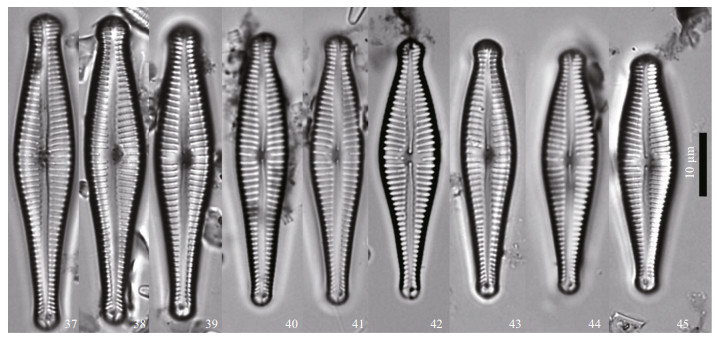
|
| Plate 5 Gomphonema pseudosphaerophorum H. Kobayasi in Ueyama & Kobayasi Figures 37-45: LM, valve views, showing size diminution series. |
Description: valves elliptical-lanceolate clavate, with headpole broadly capitate and rounded. Length 32–45 μm, breadth 8–9 μm. Axial area narrow at the poles, narrowly lanceolate towards the center, then laterally expanded to form a narrowly-rectangular central area. There is an isolated stria on either side of the central area, one terminating near the center with a round stigma, on the other side striae not reaching the center. Raphe undulate, lateral, with external proximal ends dilated slightly. Striae indistinctly punctate, radiate through the valve becoming parallel towards the headpole. Striae number (9–12)/10 μm. A distinct, bilobed apical pore field is present at the footpole. Septa and pseudosepta are present at the poles.
Externally, the undulate raphe is evident (Figs. 46– 49). At the apices the raphe extends onto the mantle at the headpole (Fig. 47) and bisecting the APF at the footpole (Fig. 49). The APF is composed of round porelli, which are physically separate and morphologically distinct from the areolae (Fig. 49). At the central area of the valve, the proximal raphe ends are dilated. There is a round stigma opening on one side of the central area, quite distinct in size and shape from the narrow, lunate areolae (Fig. 48). The uniseriate striae are composed of lineate areolae near the margins, and C-shaped or lunate areolae near the axial area (Figs. 46–49).
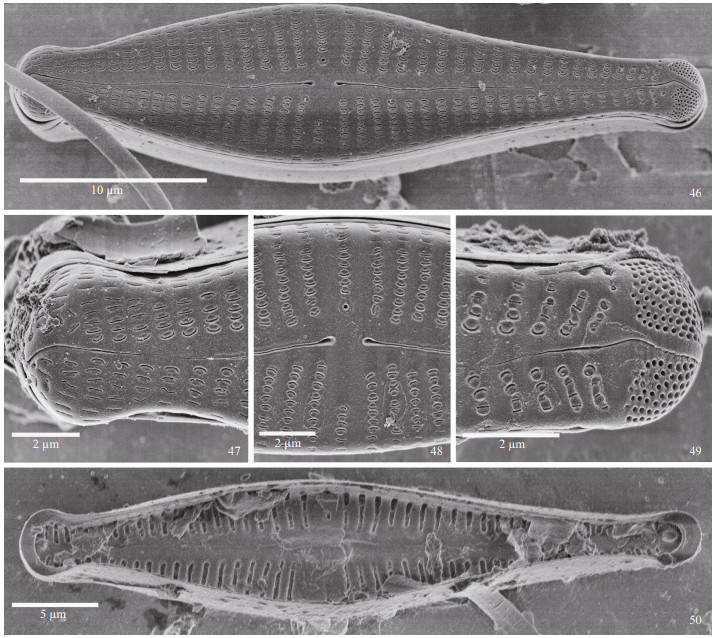
|
| Plate 6 Gomphonema pseudosphaerophorum H. Kobayasi in Ueyama & Kobayasi Figures 46-50: SEM; Figs. 46-49: external views; Fig. 46: entire valve, with undulate raphe, C-shaped areolae and small round stigma positioned near a central stria in the central area; Fig. 47: headpole, with narrowly-lunate areolar openings and raphe deflected onto mantle; Fig. 48: central area showing dilated proximal raphe ends radiate striae and round stigma opening; Fig. 49: footpole, with strongly radiate striae and APF porelli physically separate and morphologically distinct from areolae; Fig. 50: internal view. Entire valve with large central nodule and pseudosepta evident. |
Internally, there is a small, barely-distinguished central nodule (Fig. 50). Distally, the raphe terminates as helictoglossae. On the central nodule the stigma opening is slit-like. Striae bear thickenings that separate the areolae and connect between the robust interstriae. At the headpole and footpole pseudosepta are distinct.
Comments: This species is known throughout Asia (Ueyama and Kobayasi, 1988; Wang et al., 2000), and has more recently been documented from Hawaii (Miscoe et al., 2016).
Gomphonema lanceolatoides sp. nov.Figures 51–70. Figure 52 is of the holotype.
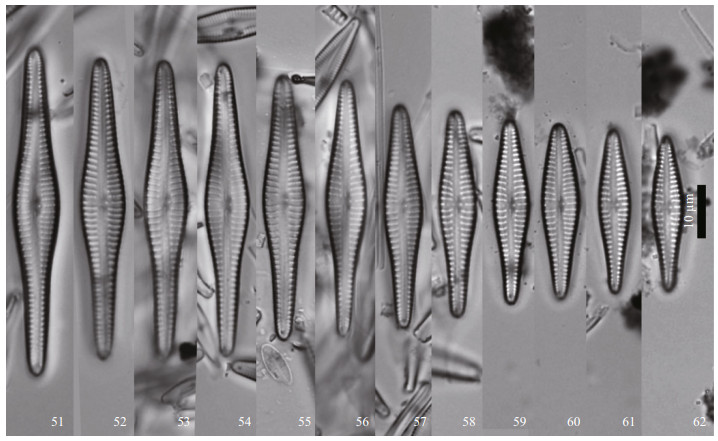
|
| Plate 7 Gomphonema lanceolatoides sp. nov. Figures 51-62: LM, valve views, showing size diminution series. Figure 52 is of the holotype. |
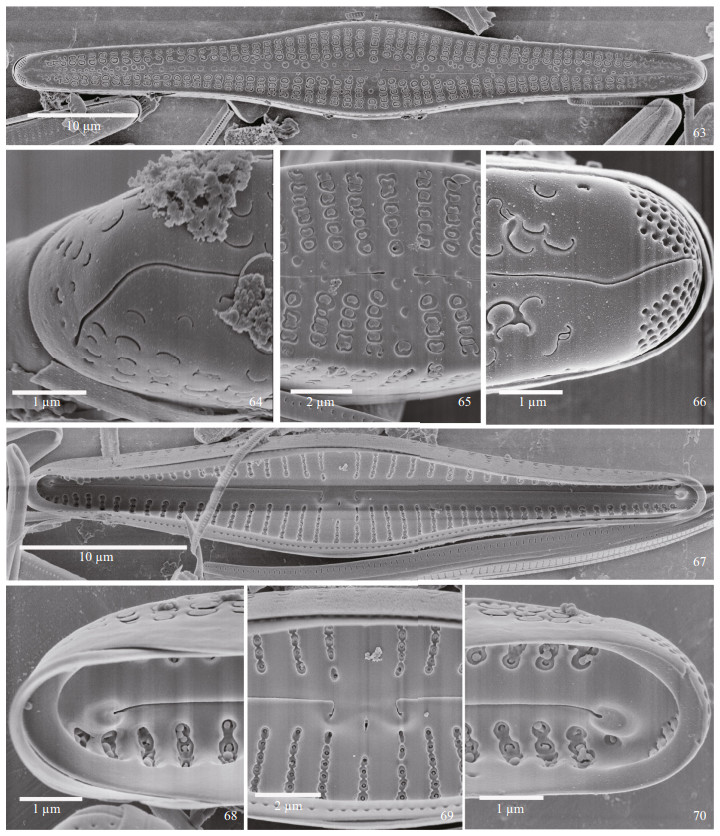
|
| Plate 8 Gomphonema lanceolatoides sp. nov. Figures 63-70: SEM; Figs. 63-66: internal views; Fig. 63: entire valve, showing outline and C-shaped areolae with externally-raised flaps; Fig. 64: headpole, showing distal raphe end curved onto the valve mantle; Fig. 65: central area with striae composed of areolae with occlusions. Areolae and small, round stigma opening appear in depressions. The proximal raphe ends are dilated slightly; Fig. 66: footpole, with raphe curved on the valve face and continuing onto the mantle, bisecting the APF. APF more or less positioned on the mantle only. Porelli are distinct, physically removed and morphologically differentiated, from the areolae; Figs. 67-70: internal views; Fig. 67: whole valve with distinct, bilobed central nodule evident. Striae occur in troughs, and the stigma is positioned on one side of the base of the central nodule. Pseudosepta are helictoglossae are evident at the poles; Fig. 68: headpole. Helictoglossa is offset from main axis of the raphe. Areolae appear to have internal occlusions; Fig. 69: central area, with central nodule bearing recurved proximal raphe ends and stigma opening that is round-ellipsoidal in shape. Troughs with small pegs protruding into them, sometimes connecting from the sides. Areolae have occlusions; Fig. 70: footpole, with pseudoseptum and helictoglossa that is offset from the main raphe axis are prominent. APF porelli appear occluded as do areolae. |
Description: valves linear-lanceolate to lanceolateclavate, with rounded apices. Length 29.5–60.0 μm, breadth 6.5–8.5 μm. Axial area narrow, straight, expanded slightly towards both margins to form an indistinct central area. An isolated stria on one side of the central area is elongated and ends at a distinct, round stigma. The striae on the other side not reaching the center. Raphe is weakly lateral and undulate. External proximal ends indistinct. Striae indistinctly punctate, radiate near the center, become parallel towards the headpole and footpole but radiate again at the footpole. Striae number (9–11)/10 μm. Apical pore field small, bilobed. Septa and pseudosepta present at the poles.
SEM observations: Externally, the valve face is dominated by the areolae with C-shaped occlusions which, in some specimens, appear as though they have additional silica on them (Figs. 63–66). The raphe is undulate, with proximal raphe ends dilated slightly, and distal raphe ends deflected onto the valve margin (Figs. 63–66). The stigma opening is round, positioned just off a central stria (Fig. 65). At the footpole, the raphe bisects the APF, which is almost entirely situated on the mantle. The APF is composed of round porelli, physically differentiated and separated from the areolae.
Internally, the apices bear septa and pseudosepta (Figs. 67, 68, 70). The position of the helictoglossae is offset from the raphe branch. The central nodule is undulate and bears the recurved proximal raphe ends. The stigma opening is small and rounded (Fig. 69). Siliceous peg-like growths can be seen in the striae, which occur in deep troughs. The external occlusions of the areolae can be seen from the valve interior (Figs. 68–70).
Holotype: 201805021-1, holotype illustrated in Fig. 52. Isotype JPK Collection, COLO, slide number to be indicated upon acceptance of manuscript.
Type locality: Henan Province, Yuntai Mountains, Tanpu valley, river, periphyton, China (35°27′31′′N, 113°20′50″E).
Etymology: named for the similarity in valve shape to G. lanceolatum C. A. Agardh.
Gomphonema montanaviva sp. nov.Figures 71–89. Figure 77 is of the holotype.
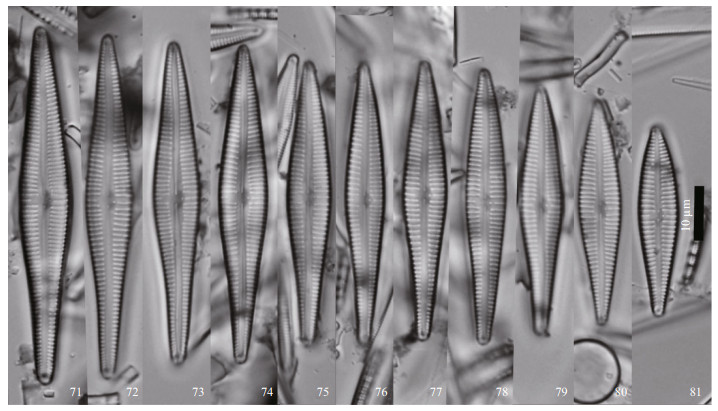
|
| Plate 9 Gomphonema montanaviva sp. nov. Figures 71-81: LM, valve views, showing size diminution series. Figure 77 is of the holotype. |
Description: valves lanceolate-clavate, with apices rounded. Length 42–70 μm, breadth 8–9 μm. Axial area linear-lanceolate, with central area barely distinguished. Striae in the center of the valve slightly coarser than the rest of the valve, with one side of the central area with a short stria, the other side with a more elongated stria. A single round stigma opening is present at the end of one of the elongated central striae. Raphe lateral, arched. External proximal raphe ends dilated slightly. Striae punctate, radiate. Striae number (8–10)/10 μm at the center of the valve, (11– 15)/10 μm at the spices. Bilobed apical pore field present at the footpole. Small septa and pseudosepta present at the poles.
SEM observations: externally, the elongated valves have an undulate raphe and distinct, round stigma (Fig. 82). At the headpole, striae are seen to extending around the pole onto the mantle. The distal raphe end is deflected onto the mantle. C-shaped areolae are prominent in the striae (Fig. 83). In the center of the valve, striae are composed on C- or E-shaped areolae, formed by external occlusions. Proximal raphe ends are dilated slightly, and the stigma opening is round (Fig. 84). At the footpole, the distal raphe end is strongly deflected onto the mantle, bisecting the apical pore field. The bilobed pore field is comprised on round porelli, organized into discreet rows. Porelli are morphologically distinct from the C-shaped areolae and physically separated from them (Fig. 85).
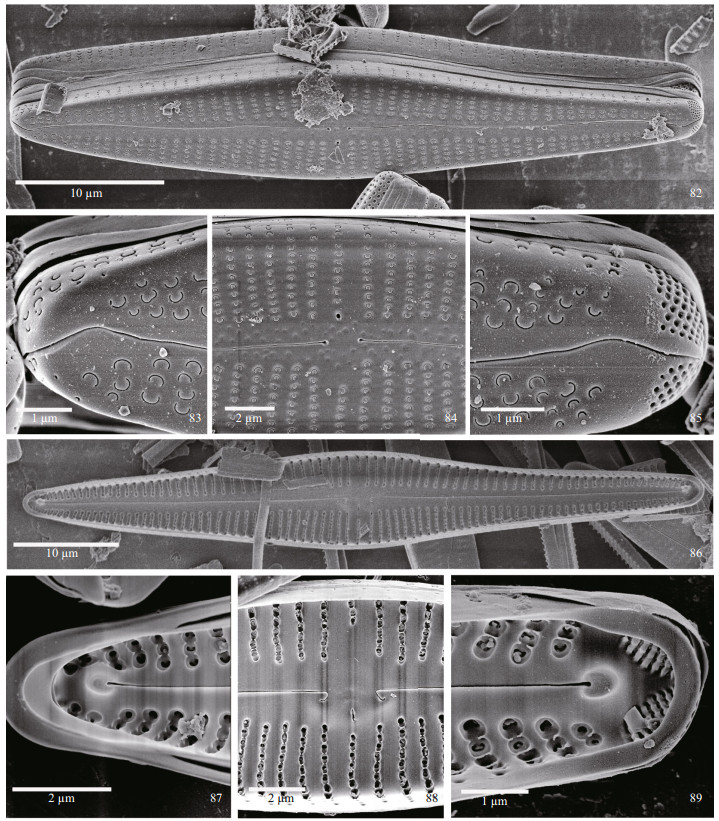
|
| Plate 10 Gomphonema montanaviva sp. nov. Figures 82-89: SEM; Figs. 82-85: external views; Fig. 82: whole frustule, with the shape of the valve and undulate nature of the raphe evident; Fig. 83: headpole. Areolae are C-shaped with occlusions and the distal raphe end bends onto the valve mantle; Fig. 84: central portion of the valve has parallel to slightly radiate striae, a distinct, round stigma opening and proximal raphe ends that are dilated slightly; Fig. 85: footpole, with striae strongly radiate bearing C-shaped areolae. The APF is positioned on the mantle and has round porelli; Figs. 86-89: internal views; Fig. 86: entire valve view. The central nodule is small and rounded and helictoglossae and pseudosepta are present at the poles; Fig. 87: headpole, with both septum and pseudoseptum evident. The helictoglossa is prominent, and offset from the main axis of the raphe. Small, peg-like projections are evident in the etroughs bearing the striae; Fig. 88: central portion of the valve, with small round central nodule with recurved proximal raphe ends and slit-like stigma present; Fig. 89: footpole, with pseudoseptum and helictoglossa evident. APF porelli appear occluded. Troughs of the striae have small, peg-like projections. |
Internally, the frustules can be seen to have septa (Fig. 87) and pseudosepta (Figs. 86 & 89). At the headpole the helictoglossa is offset from the raphe branch. The small tooth-like projections can be seen at the headpole (Fig. 87). At the center of the valve the small central nodule bears recurved proximal raphe ends and the slit-like opening of the stigma. Alveoli of the striae have thin, peg-like projections, and many fused to form distinct squarish compartments (Fig. 88). At the footpole, the helictoglossa is aligned with the raphe branch, and porelli of the pore field are occluded (Fig. 89).
Comments: this taxon appears similar to some treatments of G. gracile C. G. Ehrenberg. Gomphonema gracile has been treated in mostly a broad sense (see Germain, 1981; Krammer and Lange-Bertalot, 1986, 1991), with populations having relatively wide and relatively narrow proportions given the same name. Reichardt (2015) designated a Lectotype from Ehrenberg's collection, and specimens from that gathering have headpoles that are more rounded and possibly more similar to G. dichotomum Kützing. Reichardt suggested that diatoms more similar to the commonly-applied concept of G. gracile can be assigned to the name G. naviculoides W. Smith, a form that is nearly symmetrical to the transapical axis (as its name implies), which differs from G. montanaviva. Reichardt (2015) illustrated Smith's type, and suggested this species can be found in the tropics and North America, but that specimens conforming to the type are rare in Europe. Reichardt (2015) also described some new species that might have previously be confused with G. gracile sensu lato, including G. graciledictum Reichardt, a diatom with an overall shape similar to G. montanaviva, but where the vegetative valves are distinctly smaller (20–53 μm long, 6.0–7.5 μm wide in G. graciledictum as compared to 42–70 μm long, 8–9 μm wide in G. montanaviva). The longest valves illustrated by Reichardt for his taxon look quite unlike the smallest valves of G. montanaviva, even though they are the nearly the same size.
Holotype: 201805021-1, holotype illustrated in Fig. 77. Isotype JPK Collection, COLO, slide number to be indicated upon acceptance of manuscript.
Type locality: Henan Province, Yuntai Mountains, Tanpu valley, river, periphyton, China (35°27′31′′N, 113°20′50″E).
Etymology: named for living in mountainous regions.
Gomphonema pseudintricatum sp. nov.Figures 90–109. Figure 95 is of the holotype.
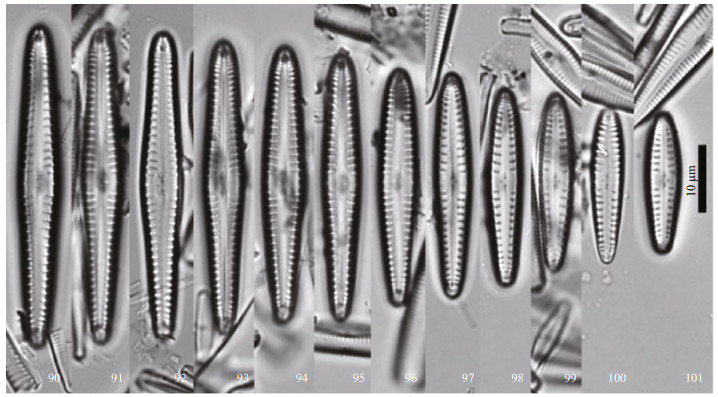
|
| Plate 11 Gomphonema pseudintricatum sp. nov. Figures 90-101: LM, valve views, showing size diminution series. Figure 96 is of the holotype. |
Description: valves linear-clavate, margins nearly straight, with apices rounded. Length 28.0–50.5 μm, breadth 5–8 μm. Axial area narrow at the poles, lanceolate in shape until becoming the rectangular central area with a single shortened stria on either side. Raphe straight, lateral, with dilated external proximal raphe ends and distinctly recurved internal proximal raphe ends. A single round stigma opening is positioned near the external proximal raphe ends. Striae indistinctly punctate, radiate, (9–11)/10 μm, striae condensed around the headpole. A distinct, bilobed apical pore field is located at the footpole. Septa and pseudosepta are present at the poles.
SEM observations: externally, each branch of the raphe is seen to be arched, with the proximal ends dilated and rounded and the distal ends weakly deflected and extending onto the valve mantle (Figs. 102–105). A round stigma of approximately the same size as the areolae, is positioned near the proximal raphe ends in the central area of the valve (Figs. 102 & 104). Striae are composed of rounded areolae that are without occlusions (see arrow) (Figs. 103–105). Striae extend from the valve face to the mantle. At the headpole, striae are more condensed, and the areolae appear more lineate in shape (Fig. 103). At the footpole, the raphe bisects the APF, which extends from the valve face onto the mantle (Fig. 105). Porelli of the APF are physically separated and morphologically distinct from the areolae (Fig. 105).

|
| Plate 12 Gomphonema pseudintricatum sp. nov. Figures 102-109: SEM; Figs. 102-105: external views; Fig. 102: entire valve view, showing linear-clavate outline, raphe branches that are slightly arched and have dilated proximal ends. APF is evident at the footpole; Fig. 103: headpole, with lineate-like striae. Distal raphe end extends onto the valve mantle; Fig. 104. Central part of the valve with slit-like or ellipsoidal areolae present. Proximal raphe ends are dilated and are positioned close to one another. A small, round stigma opening is evident; Fig. 105: footpole. Raphe bisects the APF. Porelli are physically separated from the areolae, and morphologically distinct from them; Figs. 106-109: internal views; Fig. 106: entire valve view with distinct pseudosepta and helictoglossae at the poles; Fig. 107: septum and pseudoseptum are evident, nearly covering the helictoglossae; Fig. 108: central nodule, with recurved proximal raphe ends. The small round stigma opening is occluded. Areolae are also occluded internally; Fig. 109: footpole. Septum and pseudoseptum are present. The helictoglossa is offset from the axis of the raphe. |
Internally, the central nodule is evident and the helictoglossa at each apex is quite large (Figs. 106, 107, S109). The central nodule bears the recurved proximal raphe ends. The stigma is covered by an occlusion, and the areolar openings are also occluded internally (Fig. 108). A prominent septum and pseudoseptum is present at each apex (Figs. 107 & 109).
Holotype: 201805021-1, holotype illustrated in Fig. 95. Isotype JPK Collection, COLO, slide number to be indicated upon acceptance of manuscript.
Type locality: Henan Province, Yuntai Mountains, Tanpu valley, river, periphyton, China (35°27′31′′N, 113°20′50″E).
Etymology: the name refers to the close resemblance of this to Gomphonema intricatum.
Comments: this species is differentiated from G. vibrio and G. intricatoides You & Kociolek (in You et al., 2015) by the narrower, linear outline of the valve. Gomphonema vibrio (see below) is also missing the internal areolar and stigma occlusions found in G. pseudintricatum.
Gomphonema vibrio Ehrenberg 1843Figures 110–126.
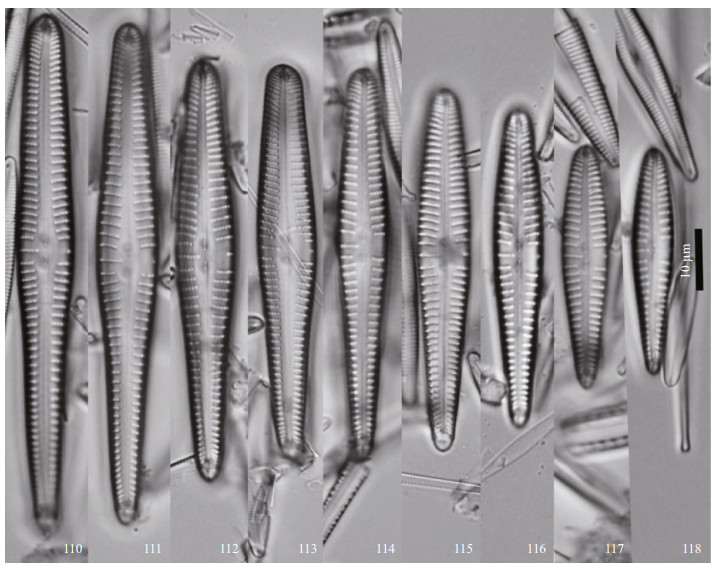
|
| Plate 13 Gomphonema vibrio Ehrenberg Figures 110-118: LM, valve views. Size diminution series. |
Description: valves linear-lanceolate-clavate, with broadly rounded headpole and rounded footpole. Length 53–122 μm, breadth 8–13 μm. Axial area narrow at the poles, widening slightly and straight the rest of the length of the valve. Raphe straight, slightly lateral. External proximal raphe ends straight, slightly dilated; distal raphe ends bent in the same direction. Internal proximal raphe ends distinct, recurved. Central area comprised of striae more coarsely separate than the rest, a single stria on either side of the central area. On one side the stria is elongated and terminates at a small, round stigma; on the other side the stria is shortened. Stria are punctate, radiate, strongly so are the poles. Striae number (7–9)/10 μm most of the length of the valve, (11–13)/10 μm at the poles. A distinct bilobed apical pore field is present at the footpole. Septa and pseudosepta are present, distinct.
SEM observations: externally, valves linearlanceolate clavate, with a relatively straight raphe, the areolae are rounded without occlusions, and apical pore fields are prominent (Fig. 119). At the headpole the raphe is weakly deflected and extends onto the mantle. Striae are denser than at the center of the valve, and the areolae are oval to ellipsoidal (Fig. 120). At the center of the valve the proximal raphe ends are distinctly dilated. The stigma opening is round. Silica bordering the raphe opening may have wave-like edges (Fig. 121). At the footpole, areolae may be in small, semi-circular depressions near the raphe slit or flat on the face of the valve. The distal raphe end is weakly deflected and bisects the apical pore field and extends onto the mantle. Porelli of the apical pore field are round, being physically separated from the areolae and slightly morphological differentiated from them (Fig. 122).
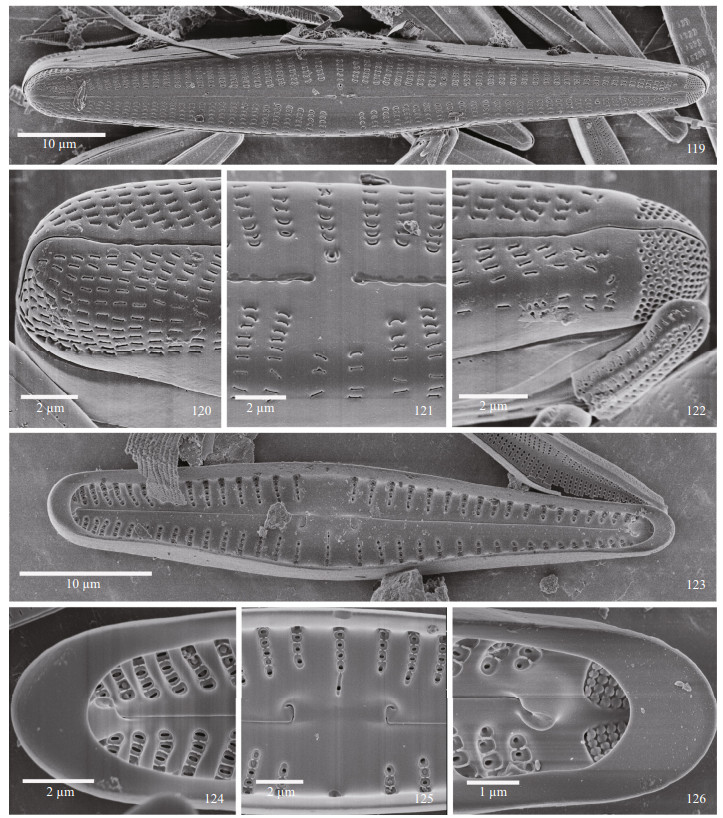
|
| Plate 14 Gomphonema vibrio Ehrenberg Figures 119-126: SEM; Figs: 119-122, external views; Fig. 119: entire valve view. Nearly straight raphe and radiate striae are evident. APF is present at the footpole; Fig. 120: headpole, with slit-like areolae comprising the striae. Distal raphe end occurs on the mantle; Fig. 121: central area. Areolae are straight or curved. The round stigma opening occurs in a shallow depression; Fig. 122: footpole, showing the APF occurs on the valve face and mantle, and is bisected by the distal raphe end. The porelli appear segregated from the areolae and morphologically differentiated from them; Figs. 123-126: internal views; Fig. 123: entire valve, with distinct pseudosepta at the poles; Fig. 124: headpole, with wide pseudoseptum and prominent helictoglossa present. Peg-like projections occur in the depressions housing the striae; Fig. 125: central area with recurved proximal raphe ends positioned at the ends of the central nodule. The stigma opening is round, with a slit-like extension towards the striae. A few areolae have internal occlusions; Fig. 126: footpole with pseudoseptum and large helictoglossa evident. Striae have small peg-like extensions. Porelli appear occluded. |
Internally, the swollen central nodule, and pseudosepta at the poles are distinct (Fig. 123). At the headpole (Fig. 124), the pseudoseptum is large; the helictoglossa is distinct and more or less aligned with the raphe. At the valve center, the elongated central nodule bears the recurved proximal raphe ends. The stigma opening is occluded. Alveoli have smaller compartments or depressions formed by small projections between the areolae within each striae. A few examples of areolar occlusions are evident (Fig. 125). At the footpole (Fig. 126) the helictoglossa is offset from the raphe slit and the pseudoseptum is large. Porelli are occluded internally.
Comments: the internal occlusions of the areolae easily assign this taxon to the "Intricatum" group of Gomphonema (Kociolek and Stoermer, 1993; Jüttner et al., 2018).
Gomphonema fortissimo sp. nov.Figures 127–143. Figure 128 is of the holotype.

|
| Plate 15 Gomphonema fortissimo sp. nov. Figures 127-135: LM, valve views. Showing size diminution series. Figure 128 is of the holotype. |
Description: valves lanceolate-clavate, with headpole indistinctly protracted and broadly rounded; footpole rounded. Length 21–47 μm, breadth 5–8 μm. Axial area narrow, widening slightly towards the center to form an irregular central area. A single stria, somewhat shorter than the others, is on either side on the central area. A single round stigma opening is located to one side of the valve center, near the proximal raphe ends. Raphe undulate, lateral for most of its length. Striae radiate near the valve center, parallel towards and at both apices. Striae number (9–12)/10 μm. A small apical pore field is present at the footpole. Septa and pseudosepta are present at the poles.
SEM observations: valves distinctly clavate, with wide headpole and rounded footpole. Externally, the valve has a distinctly undulate raphe, with proximal ends dilated and distal ends strongly curved onto the mantle (Fig. 136). At the headpole, the areolae are slitlike to C-shaped, and the distal raphe end can be seen curving at an approximately 45-degree angle onto the mantle. Striae are continuous about the headpole (Fig. 137). In the center of the valve the dilated proximal raphe ends and rounded stigma are evident. Areolae comprising the striae are C-, E- or S-shaped (Fig. 138). At the footpole, the striae are separated near the margin, with slit-like striae near the margin and C-shaped striae closer to the axial area. The raphe is curved, and strongly deflected on the mantle bisecting the apical pore fields. Porelli of the apical pore fields are positioned more on the mantle than the valve face. Porelli are round, morphologically differentiated from the areolae and physically separated from them (Fig. 139).
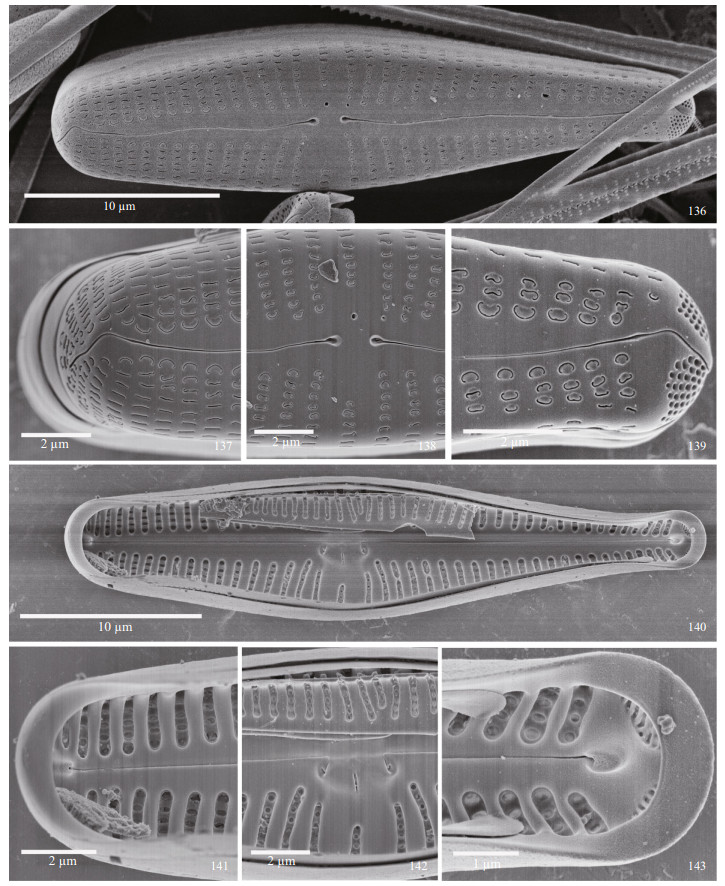
|
| Plate 16 Gomphonema fortissimo sp. nov. Figures 136-143: SEM; Figs. 136-139: external views; Fig. 136: whole valve. Undulate raphe and dilated proximal raphe ends are evident; Fig. 137: headpole, with striae composed of c-shaped and lineate areolae. Distal raphe end is bent onto the mantle; Fig. 138: central area. Proximal raphe ends are dilated. The stigma opening is round and unoccluded; Fig. 139: footpole, with APF positioned almost entirely on the mantle. Porelli are physically separate, and morphologically distinct from the areolae; Figs. 140-143: internal views; Fig. 140: entire valve. The mound-like central nodule bears the proximal raphe ends and slit-like stigma. Pseudosepta and helictoglossae are positioned at the poles; Fig. 141: headpole, with shallow pseudoseptum and helictoglossa; Fig. 142: central nodule, with proximal raphe ends positioned at the base. Slit-like stigma opening is present; Fig. 143: footpole. The helictoglossa is large and in alignment with the raphe slit. The pseudoseptum nearly covers the APF porelli. |
Internally, the hemispherical central nodule extends to one side of the raphe, bearing recurved proximal raphe ends and a slit-like stigma opening. Striae are contained in alveolar grooves or troughs, without any occlusions evident. Areolar openings are round (Figs. 140 & 142). At the headpole, the helictoglossa is aligned, not offset, from the raphe slit. A narrow pseudoseptum is present (Fig. 141). At the footpole, the apical pore field is seen to be asymmetrical with one group of pores larger than the other. The porelli are occluded. The helictoglossae is slightly offset from the raphe slit, and the pseudoseptum is small (Fig. 143).
Holotype: 201805046-1, holotype illustrated in Fig. 128. Isotype JPK Collection, COLO, slide number to be indicated upon acceptance of manuscript.
Type locality: Henan Province, Yuntai Mountains, Tanpu valley, river, periphyton, China (35°28′52′′N, 113°39′21″E).
Etymology: this species is named for its small but stout size.
4 DISCUSSIONThis report represents the first detailed investigation of the freshwater diatom genus Gomphonema of Henan Province. While others have considered new taxa of the genus from a variety of places across the country, including the east (Zhang et al., 2016, 2018a, b), northeast (Skvortzow, 1929, 1935, 1946; Bao and Reimer, 1992; Fan et al., 2004; Liu et al., 2013), northwest (You et al., 2015), and southwest (Shi, 2004; Li et al., 2006, 2010; Jiang et al., 2018), as well as Tibet (Mereschkowsky, 1906), few studies have focused on the central portion of China.
The Yuntai Mountains have a wide variety of Gomphonema morphologies included in the region. Several morphological groups have been recognized for the genus (Kociolek and Stoermer, 1993; Reichardt and Lange-Bertalot, 1991; Reichardt, 1999; Kociolek and Kingston, 1999; Reichardt, 2015; Kociolek et al., 2016; Levkov et al., 2016; Jüttner et al., 2018) and, has been reported previously froom Hawaii (Kociolek et al., 2016) and Nepal (Jüttner et al., 2018). The Yuntai Mountains have a set of species that come from several of these groups. For example, in addition to the "classical" species of the genus, which have external flaps that give the external areolar openings a characteristic C- or S- shape (such as G.lanceolatoides, G. montanaviva and G. fortissima described herein), as well as G. pseudosphaerophorum and G. vibrio, the latter taxon appears to lack areolar occlusions altogether (Jüttner et al., 2018). Also present are species that have internal areolae occlusions, such as G. cf. lateripunctatum and G. pseudintricatum sp. nov. Cox (2004) termed these internal occlusions "tectula" and suggested they were supported by peglike projections. Further analysis is necessary to whether tectula and the peg-like struts that support them are homologous across the taxa that possess them.
The Gomphonema flora of the Yuntai Mountains also includes an astigmate species G. yuntaiensis that has unoccluded areolae, but also siliceous papillae positioned near the margin of the valve; this suite of morphological features has not been reported for the genus previously. Absent from this flora are species with striae composed of doubly rows of areolae (e.g. Hustedt, 1945; Reichardt, 2005; Kociolek et al., 2016), large, robust species (as seen in Lake Baikal but also SE Asia, Skvortzow and Meyer, 1928, Skvortzow, 1937; Skuja, 1937; Amossé, 1969; Kulivoskiy and Kociolek, 2014), and species with a wide axial area, often found in South America (Fricke, 1902; see also Metzeltin and Lange-Bertalot, 1998) but also known from North America and Europe (Reichardt, 2007; Stancheva et al., 2016), Africa (Cholnoky, 1953) and Asia (Hustedt, 1937).
This morphological diversity of Gomphonema taxa represented in the Yuntai Mountains may be of interest as a measure of water quality status. The Yuntai Mountains occur in a Geological Park that has national and international significance. While the park is open to the public, there is an entrance fee and activities are highly regulated. There has been no monitoring of water quality of the GeoPark's aquatic ecosystems, but a wide range of morphological diversity of Gomphonema species has been reported from other pristine environments, including the Hawaiian Islands (Kociolek et al., 2016) and a highelevation lake in the Himalayas of Nepal (Jüttner et al., 2018). Future research may support the contention that high morphological diversity among forms currently assigned to the genus Gomphonema is suggestive of increased water quality.
The diversity of forms assigned to the genus Gomphonema might suggest that additional subdivision of the genus is warranted. Such teasing apart of taxa formerly in the genus Navicula Bory and Cymbella C. A. Agardh, has led to new insights into the phylogeny of the former (Theriot et al., 2015; Kulikovskiy et al., 2019), and biogeographic trends in the latter (e.g. Kociolek, 2018). A finer-grained taxonomy of freshwater diatoms will be necessary across groups such as the genus Gomphonema (with over 2 000 described taxa; Kociolek et al., 2020), as well as Nitzschia Hassall, Pinnularia Ehrenberg, and Eunotia Ehrenberg, to name a few, to better understand the systematic relationships, evolution and biogeography of these successful lineages.
5 DATA AVAILABILITY STATEMENTAll data included in this study are available upon request by contact with the corresponding author.
6 ACKNOWLEDGMENTWe are grateful to Pan YU for his help in acquiring SEM images.
Amossé A. 1969. Note sur des Diatomées récoltées en Indochine. Revue Algologique, Nouvelle Série, 9(4): 326-344.
|
Bao W M, Reimer C W. 1992. New taxa of the diatoms from Changbaishan Mountain, China. Bulletin of Botanical Research, 12(4): 357-361.
|
Cantonati M, Angeli N, Bertuzzi E, Spitale D, Lange-Bertalot H. 2012. Diatoms in springs of the Alps: spring types, environmental determinants, and substratum. Freshwater Science, 31(2): 499-524.
DOI:10.1899/11-065.1 |
Cheng Y, Liu Y, Kociolek J P, You Q M, Fan Y W. 2018. A new species of Gomphosinica (Bacillariophyta) from Lugu Lake, Yunnan Province, SW China. Phytotaxa, 348(2): 118-124.
DOI:10.11646/phytotaxa.348.2.6 |
Cholnoky V B J. 1953. Diatomeenassoziationen aus dem Hennops-rivier bei Pretoria. Verhandlungen der Zoologisch-Botanischen Gesellschaft in Wien, 93: 134-149.
|
Cox E J. 2004. Pore occlusions in raphid diatoms-a reassessment of their structure and terminology, with particular reference to members of the Cymbellales. Diatom, 20: 33-46.
|
Delgado C, Ector L, Novais M H, Blanco S, Hoffmann L, Pardo I. 2013. Epilithic diatoms of springs and spring-fed streams in Majorca Island (Spain) with the description of a new diatom species Cymbopleura margalefii sp. nov. Fottea, 13(2): 87-104.
DOI:10.5507/fot.2013.009 |
Ehrenberg C G. 1854. Mikrogeologie. Das Erden und Felsen Schaffende Wirken des Unsichtbar Kleinen Selbstständigen Lebens auf der Erde. Leopold Voss, Leipzig. 374p.
|
Fan Y W, Shi Z X, Bao W M, Wang Q X. 2004. A new combination and two varieties of polystigmate Gomphonema (Gomphonemaceae Bacillariophyta) from Heilongjiang Province, China. Chinese Journal of Oceanology and Limnology, 22(2): 198-200.
DOI:10.1007/BF02842593 |
Foged N. 1971. Freshwater diatoms in Thailand. Nova Hedwigia, 22(1-2): 267-369.
|
Fricke F. 1902. Verzeichnis der in A. Schmidt's Atlas der Diatomaceenkunde. Tafel 1-240 (Serie I-V) adgebildeten und benannten Formen. Herausgegeben von Dr. Friedr. Leipzig, O.R. Reisland. 69pp.
|
Gandhi H P. 1958. Fresh-water diatoms from Kolhapur and its immediate environs. The Journal of the Bombay Natural History Society, 55(3): 493-511.
|
Gandhi H P. 1960. The diatom flora of Bombay and Salsette islands. The Journal of the Bombay Natural History Society, 57(1): 78-123.
|
Germain H. 1981. Flore des Diatomées Eaux Douces et Saumatres. Editions Boubée, Paris. 444p.
|
Glushchenko A, Kulikovskiy M, Kociolek J P. 2017. New diatom species from the Gomphonema subtile group in Southeast Asia. Phytotaxa, 329(3): 223-232.
DOI:10.11646/phytotaxa.329.3.3 |
Gong Z J, Li Y L. 2012. Gomphonema yaominae sp. nov. Li, a new species of diatom (Bacillariophyta) from lakes near Yangtze River, China. Phytotaxa, 54(1): 59-64.
DOI:10.11646/phytotaxa.54.1.6 |
Hustedt F. 1922. Bacillariales aus innerasien, gesammelt von Dr. Sven Hedin. In: Hedin S ed. Southern Tibet. Lithographic Institute of the General Staff of the Swedish Army, Stockholm. p. 107-152.
|
Hustedt F. 1927. Bacillariales aus dem Aokikosee in Japan. Archiv für Hydrobiologie, 18: 155-172.
|
Hustedt F. 1937. Systematische und ökologische Untersuchungen über die Diatomeen-flora von Java, Bali und Sumatra nach dem Material der Deutschen Limnologischen Sunda-Expedition. "Tropische Binnengewässer, Band Ⅶ". Archiv für Hydrobiologie, Supplement, 15: 393-506.
|
Hustedt F. 1945. Diatomeen aus seen und quellgebieten der balkanhalbinsel. Archiv für Hydrobiologie, 40(4): 867-973.
|
Jiang Z Y, Liu Y, Kociolek J P, Fan Y W. 2018. One new Gomphonema (Bacillariophyta) species from Yunnan Province, China. Phytotaxa, 349(3): 257-264.
DOI:10.11646/phytotaxa.349.3.6 |
Jüttner I, Kociolek J P, Gurung S, Gurung A, Sharma C M, Levkov Z, Williams D M, Ector L. 2018. The genus Gomphonema (Bacillariophyta) in Rara Lake, Nepal: taxonomy, morphology, habitat distribution and description of five new species, and a new record for Gomphoneis qii. Diatom Research, 33(3): 283-320.
DOI:10.1080/0269249X.2018.1528182 |
Jüttner I. 2018. Gomphonema lateripunctatum reichardt & lange-bertalot; 1991; 530. In: Jüttner I, Bennion H, Carter C, Cox E J, Ector L, Flower R, Jones V, Kelly M G, Mann D G, Sayer C, Turner J A, Williams D M eds. Freshwater Diatom Flora of Britain and Ireland. Amgueddfa Cymru - National Museum Wales. https://naturalhistory.museumwales.ac.uk/diatoms/browsespecies.php?-recid=4109.2020/01/24.
|
Kociolek J P, Balasubramanian K, Blanco S, Coste M, Ector L, Liu Y, Kulikovskiy M, Lundholm N, Ludwig T, Potapova M, Rimet F, Sabbe K, Sala S, Sar E, Taylor J, Van de Vijver B, Wetzel C E, Williams D M, Witkowski A, Witkowski J. 2020. DiatomBase. http://www.diatombase.org.2020/01/24.
|
Kociolek J P, Glushchenko A, Kulikovskiy M. 2015a. Typification, valve ultrastructure, and systematic position of Gomphonema gomphopleuroides Amosse ex Kociolek, Glushchenko and Kulikovskiy, an endemic diatom from Southeast Asia. Diatom Research, 30(3): 247-255.
DOI:10.1080/0269249X.2015.1072583 |
Kociolek J P, Kapustin D, Kulikovskiy M. 2018. A new, large species of Gomphonema Ehrenberg from ancient Lake Matano, Indonesia. Diatom Research, 33(2): 241-250.
DOI:10.1080/0269249X.2018.1513868 |
Kociolek J P, Kingston J C. 1999. Taxonomy, ultrastructure, and distribution of some gomphonemoid diatoms (Bacillariophyceae: Gomphonemataceae) from rivers in the United States. Canadian Journal of Botany, 77(5): 686-705.
DOI:10.1139/b99-007 |
Kociolek J P, Stoermer E F. 1993. Freshwater gomphonemoid diatom phylogeny: preliminary results. Hydrobiologia, 269(1): 31-38.
DOI:10.1007/BF00028001 |
Kociolek J P, Woodward J, Graeff C. 2016. New and endemic Gomphonema C. G. Ehrenberg (Bacillariophyceae) species from Hawaii. Nova Hedwigia, 102(1-2): 141-171.
DOI:10.1127/nova_hedwigia/2015/0296 |
Kociolek J P, You Q M, Wang Q X, Liu Q. 2015b. A consideration of some interesting freshwater gomphonemoid diatoms from North America and China, and the description of Gomphosinica gen. nov. Nova Hedwigia, 144: 175-198.
DOI:10.1127/nova_supp1/2015/0038 |
Kociolek J P. 2018. A worldwide listing and biogeography of freshwater diatom genera: a phylogenetic perspective. Diatom Research, 33(4): 509-534.
DOI:10.1080/0269249X.2019.1574243 |
Krammer K, Lange-Bertalot H. 1986. Bacillariophyceae. Teil 1: Naviculaceae. In: Ettl H, Gerloff J, Heynig H, Möllenhauer D eds. Süsswasserflora von Mitteleuropa. VEB Gustav Fisher Verlag, Jena. 876p.
|
Krammer K, Lange-Bertalot H. 1991. Bacillariophyceae. Teil 4: Achnanthaceae. Kritische Ergänzungen zu Navicula (Lineolatae) und Gomphonemav. In: Ettl H, Gärtner G, Gerloff J, Heynig H, Möllenhauer D eds. Süsswasserflora von Mitteleuropa. Gustav Fischer Verlag, Stuttgart. 468p.
|
Kulikovskiy M, Maltsev Y, Andreeva S, Glushchenko A, Gusev E, Podunay Y, Ludwig T V, Tusset E, Kociolek J P. 2019. Description of a new diatom genus Dorofeyukea gen. nov. with remarks on phylogeny of the family Stauroneidaceae. Journal of Phycology, 55(1): 173-185.
DOI:10.1111/jpy.12810 |
Kulivoskiy M S, Kociolek J P. 2014. The diatom genus Gomphonema Ehrenberg from Lake Baikal. I. Morphology and taxonomic history of two endemic species. Nova Hedwigia, Beihefte, 143: 507-518.
DOI:10.11646/phytotaxa.233.3.3 |
Lange-Bertalot H, Genkal S I. 1999. Diatoms from Siberia I - islands in the Arctic Ocean (Yugorsky-Shar Strait). In: Lange-Bertalot H ed. Iconographia Diatomologica. Annotated Diatom Micrographs. Vol. 6. Phytogeography-Diversity-Taxonomy. Koeltz Scientific Books, Königstein, Germany. 303p.
|
Levkov Z, Mitic-Kopanja D, Reichardt E. 2016. The diatom genus Gomphonema from the republic of Macedonia. In: Lange-Bertalot H ed. Diatoms of Europe, Vol. 8. Koeltz Botanical Books. Oberreifenberg, Germany. p. 1-552.
|
Li Y L, Gong Z J, Xie P, Shen J. 2006. Distribution and morphology of two endemic gomphonemoid species, Gomphonema kaznakowi Mereschkowsky and G. Yangtzensis Li nov. sp. in China. Diatom Research, 21(2): 313-324.
DOI:10.1080/0269249X.2006.9705672 |
Li Y L, Kociolek J P, Metzeltin D. 2010. Gomphonema sichuanensis Li & Kociolek sp. nov. and Gomphonema heilongtanensis Li, Kociolek et Metzeltin sp. nov. from two high mountain lakes, China. Diatom Research, 25(1): 87-98.
DOI:10.1080/0269249X.2010.9705831 |
Liu Y, Kociolek J P, Wang X Q. 2013. Six new species of Gomphonema Ehrenberg (Bacillariophyceae) species from the great Xing'an Mountains, northeastern China. Cryptogamie, Algologie, 34(4): 301-324.
DOI:10.7872/crya.v34.iss4.2013.301 |
Meister F. 1932. Kieselalgen aus Asien. Verlag von Gebrüder Borntraeger, Berlin. 56p.
|
Mereschkowsky C. 1906. Diatomées du Tibet. In: Imperial Russkoe geograficheskoe obshchestvo. St. Petersburg. 40p.
|
Metzeltin D, Lange-Bertalot H. 1998. Tropical diatoms from South America I. About 700 predominantly rarely known or new taxa representative of the neotropical flora. In: Lange-Bertalot H ed. Iconographia Diatomologica. Annotated Diatom Micrographs. Vol. 5. Diversity-Taxonomy-Geobotany. Koeltz Scientific Books. Königstein, Germany. 695p.
|
Miscoe L H, Johansen J R, Kociolek J P, Lowe R L. 2016. The diatom flora and cyanobacteria from caves on Kauai, Hawaii: Taxonomy, distribution, new species. Bibliotheca Phycologica, 120. Cramer in der Gebr. -Borntraeger-Verlagsbuchhandlung: Stuttgart. ISBN 978-3-443-60047-1. 152pp.
|
Reichardt E, Lange-Bertalot H. 1991. Taxonomische Revision des Artenkomplexes um Gomphonema angustum - G. dichotomum - G. intricatum - G. vibrio und ähnliche Taxa (Bacillariophyceae). Nova Hedwigia, 53(3-4): 519-544.
|
Reichardt E. 1999. Zur revision der gattung Gomphonema. Die Arten um G. affinelinsigne, G. angustatum/micropus, G. acuminatum sowie gomphonemoide Diatomeen aus dem Oberoligozän in Bohmen. In: Iconographia Diatomologica. p. 1-203.
|
Reichardt E. 2005. Die Identität von Gomphonema entolejum Østrup (Bacillariophyceae) sowie Revision ähnlicher Arten mit weiter Axialarea. Nova Hedwigia, 81(1-2): 115-144.
DOI:10.1127/0029-5035/2005/0081-0115 |
Reichardt E. 2007. Neue und wenig bekannte Gomphonema-Arten (Bacillariophyceae) mit Areolen in Doppelreihen. Nova Hedwigia, 85(1-2): 103-137.
DOI:10.1127/0029-5035/2007/0085-0103 |
Reichardt E. 2015. Gomphonema gracile Ehrenberg sensu stricto et sensu auct. (Bacillariophyceae): a taxonomic revision. Nova Hedwigia, 101(3-4): 367-393.
DOI:10.1127/nova_hedwigia/2015/0275 |
Schmidt A. 1899. Atlas der Diatomaceen-kunde. Leipzig: O.R. Reisland, Series V (Heft 54). Plates: 213-216.
|
Shi Z X. 2004. Flora Algarum Sinicarum Aquae Dulcis. Tomus XⅡ. Bacillariophyta. Gomphonemaceae. Science Press, Beijing. 147p.
(in Chinese)
|
Skuja H. 1937. Algae. In: Handel-Mazzetti H ed. Symbolae Sinicae: Botanische Ergebnisse der Expedition der Akademie der Wissenschaften in Wien nach Sudwest-China 1914-1918. Wien. 105p.
|
Skvortzow B W, Meyer C I. 1928. A contribution to the diatoms of Baikal Lake. Proceedings of the Sungaree River Biological Station, 1(5): 1-55.
|
Skvortzow B W. 1929. Freshwater Diatoms from Amoy, South China. The China Journal Shanghai, 2: 40-44.
|
Skvortzow B W. 1935. Diatomées récoltées par le Père E. Licent au cours de ses voyages dans le Nord de la Chine. au bas Tibet, en Mongolie et en Mandjourie. Publications du Musée Hoangho Paiho de Tien Tsin. Tienstsin, 36: 1-43.
|
Skvortzow B W. 1937. Neogene diatoms from eastern Shantung. Bulletin of the Geological Society of China, 17(2): 193-208.
DOI:10.1111/j.1755-6724.1937.mp17002006.x |
Skvortzow B W. 1938. Diatoms from Chengtu, Szechwan, western China. Philippine Journal of Science, 66: 479-496.
|
Skvortzow B W. 1946. Species novae et minus cognitae Algarum, Flagellatarum et Phycomicetarum Asiae, Africae, Ameriae et Japoniae nec non Ceylon anno 1931-1945, descripto et illustrato per tab. 1-18. Proceedings of the Harbin Society of Natural History and Ethnography. Botany. Harbin, 2: 1-34.
|
Stancheva R, Sheath R G, Kociolek J P. 2016. New freshwater gomphonemoid diatoms from streams in the Sierra Nevada Mountains, California, USA. Phytotaxa, 289(2): 118-134.
DOI:10.11646/phytotaxa.289.2.2 |
Theriot E C, Ashworth M P, Nakov T, Ruck E, Jansen R K. 2015. Dissecting signal and noise in diatom chloroplast protein encoding genes with phylogenetic information profiling. Molecular Phylogenetics and Evolution, 89: 28-36.
DOI:10.1016/j.ympev.2015.03.012 |
Trobej M, Bednar J P, Waringer J, Schagerl M. 2017. Algal communities of spring-associated limestone habitats. Aquatic Microbial Ecology, 80(1): 61-75.
DOI:10.3354/ame01836 |
Ueyama S, Kobayasi H. 1988. Two Gomphonema species with strongly capitate apices: G. sphaerophorum Ehr. and G. pseudosphaerophorum sp. nov. In: Proceedings of the 9th Diatom Symposium, Bristol, August 24-30, 1986. Biopress Ltd., Bristol, and Koeltz Scientific Boooks, Koenigstein. p. 449-458.
|
van Heurck H. 1880. Synopsis des Diatomées de Belgique. Atlas. Ducaju & Cie, Anvers, https://doi.org/10.5962/bhl.title.1990.
|
Wang Q, Zhi C Y, Hamilton P B, Kang F X. 2000. Diatom distributions and species optima for phosphorus and current velocity in rivers from Zhujiang watershed within a karst region of South-central China. Fundamental and Applied Limnology/Archiv für Hydrobiologie, 175(2): 125-141.
|
You Q M, Wang Q X, Kociolek J P. 2015. New Gomphonema Ehrenberg (Bacillariophyceae: Gomphonemataceae) species from Xinjiang province, China. Diatom Research, 30(1): 1-12.
DOI:10.1080/0269249X.2014.952783 |
Zhang W, Du C L, Kociolek J P, Zhao T T, Wang L Q. 2018b. Gomphonema wuyiensis sp. nov., a new freshwater species (Bacillariophyceae) from Wuyi Mountains, China. Phytotaxa, 375(1): 113-120.
DOI:10.11646/phytotaxa.375.1.8 |
Zhang W, Shang G X, Kociolek J P, Wang L Q, Tan H X. 2018a. Gomphonema bicepiformis sp. nov., a new diatom species (Bacillariophyta) from a stream in Zhejiang, China. Phytotaxa, 375(4): 274-282.
DOI:10.11646/phytotaxa.375.4.3 |
Zhang W, Xu X Y, Kociolek J P, Wang L Q. 2016. Gomphonema shanghaiensis sp. nov., a new diatom species (Bacillariophyta) from a river in Shanghai, China. Phytotaxa, 278(1): 29-38.
DOI:10.11646/phytotaxa.278.1.3 |
 2021, Vol. 39
2021, Vol. 39


